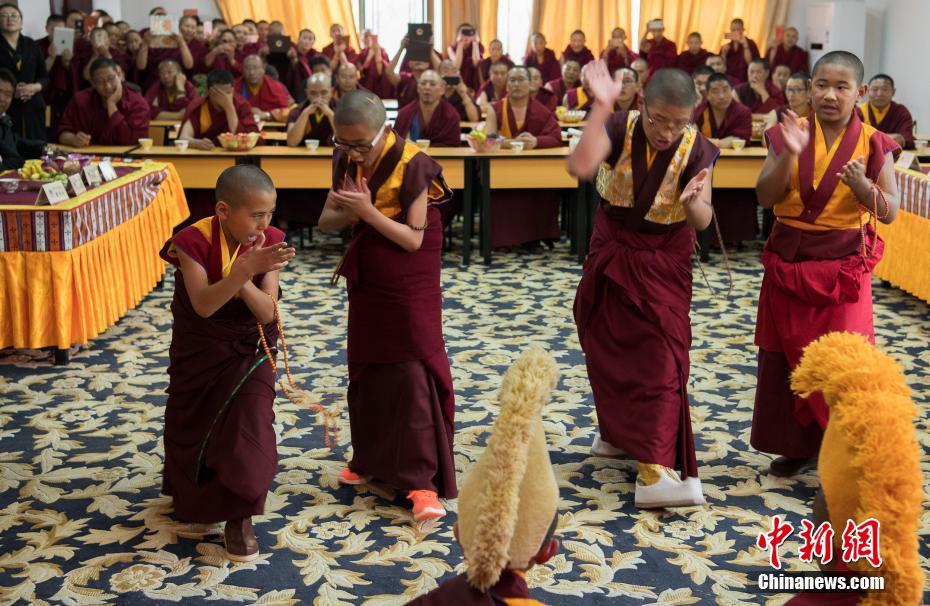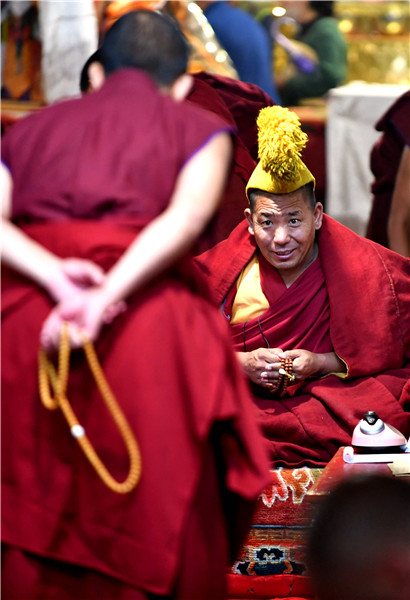Ten years since the release of the rule on the reincarnation of Living Buddha in Tibetan Buddhism
The Rule on the Reincarnation of Living Buddha in Tibetan Buddhism, issued by the State Administration for Religious Affairs of the People's Republic of China (PRC), was officially implemented on September 1, 2007. This is an important measure for the Chinese government in protecting religious freedom in accordance with the law. The rule has already been in use for ten years, during which the reincarnations of a number of Living Buddhas have been identified. The Living Buddha reincarnation system is fully respected and completely inherited.
Historical lineage
From the 13th century onwards, the Chinese central government formally incorporated Tibet into the central administration and gradually formed the relevant rules and systems for senior religious figures of Tibetan Buddhism and their reincarnation.
During the Yuan Dynasty Tibetan Buddhism's Karma Kargyu sect used the reincarnation method to solve the heritage problem of religious power, which is the first time in the history of Tibetan Buddhism that a young child has been confirmed as the reincarnation of his elder. After this, other Tibetan Buddhist sects followed suit.
After hundreds of years' practicing, stable religious rituals of searching and identifying reincarnated soul boys have formed. The most important of those are: praying for the reincarnated, consulting and watching holy lake development, and undercover searches.
As the two major Living Buddha reincarnation systems of Gelug sect in Tibetan Buddhism, the title of Dalai Lama and Panchen Erdeni, were granted by the central government of Qing Dynasty in 1653 and 1713 respectively. They also received the gold seal of approval, thus establishing the system that the successive Dalai Lama and Panchen Erdeni must be approved by the central government and awarded with official seals. In 1793 Emperor Qianlong established the “drawing lots from urn” system, creating a method and historical convention for the central government to manage the reincarnation of Living Buddhas in Tibetan Buddhism.
Living Buddha management system continued to improve after this. In 1935 the then central government followed the historical convention of Qing Dynasty and issued the Regulations for Managing Lama Temples. In 1936 the Act on the Reincarnation of Lamas was released, providing legal provisions to important matters related to the reincarnation of the Dalai Lama, the Panchen Lama and other Living Buddhas.
Reincarnation of the 11th Panchen Lama
In the new era the reincarnation work of several Living Buddhas in southwest China's Tibet Autonomous Region and the Tibetan-inhabited areas in Qinghai, Gansu, Sichuan and Yunnan Province have completed. Among them what attracted the most attention is the reincarnation of the 10th Panchen Lama, who passed away in 1989.
In relation to the search for the 10th Panchen Lama's reincarnation, Zhu Kang Living Buddha revealed some details: "The 10th Panchen Lama came to Nagqu in 1985 to recite the scriptures. He repeatedly said: ‘I really like Nagqu and the pastoral areas; I must come to Nagqu in the future.' This became the prophecy for finding and confirming his reincarnation after his death. In the end, his reincarnation just appeared in Nagqu (Jiali County)."
The search and identification of the 10th Panchen Lama's reincarnation was carried out in strict accordance with religious rituals and procedures.
Famous Tibetologist Lhapa Phuntsok said that the reincarnation of Living Buddha is not a simple process, especially for Living Buddhas above Hutuktu like the Dalai Lama, the Panchen Lama and so on. Instructions for the reincarnated soul boys must be asked for from the central government, and only when approval is received the search for the reincarnated can start.
On 29 November, 1995, the ceremony of drawing lots from the golden urn was held in front of the Sakyamuni Buddha statue at Lhasa's Jokhang Temple, and on December 8 the 11th Panchen Lama was officially enthroned, making it the largest scale reincarnation with the greatest impact since the new China was established.
Reincarnation of the 6th Dedruk Living Buddha
The 6th Dedruk Jamyang Sherab Palden Living Buddha, from Shannan in southwest China's Tibet, is the first Living Buddha to be identified by drawing lots from the golden urn since the Rule on the Reincarnation of Living Buddha in Tibetan Buddhism was issued.
Dedruk Living Buddha is from Zagor Temple in Longzi County of Shannan. All Dedruk Living Buddhas are very familiar with the religious scriptures and several of them once held the post of Ganden Chiba (Abbot of the Ganden Monastery, the Gelug sect's firstly established monastery). Because of greater influence of the Dedruk Living Buddha reincarnation system in the Buddhist world, the local government was very cautious when searching for and identifying the reincarnated soul boy.
The 5th Dedruk Jampel Kelsang Gyatso passed away on March 11, 2000. The People's Government of the Tibet Autonomous Region formed a reincarnated soul boy search team, in accordance with the Rule on the Reincarnation of Living Buddha in Tibetan Buddhism and conforming to religious rituals and historical conventions. After undercover searches in 18 counties and more than 900 rural communities, they gradually reduced the candidates of reincarnated souls to 25 and then four. Finally, they selected two boys with the most obvious lucky omen. On July 4, 2010, in front of the Sakyamuni Buddha at Lhasa's Jokhang Temple, the 11th Panchen Lama Bainqen Erdini Qoigyijabu drew lots from the golden urn, thus the reincarnated soul boy of 5th Dedruk Living Buddha was identified and also approved by the People's Government of the Tibet Autonomous Region. The 11th Panchen Lama did the tonsure for the 6th Dedruk Living Buddha and granted him the name Dedruk Jamyang Sherab Palden. On August 2, 2010, the enthronement ceremony for the 6th Dedruk Jamyang Sherab Palden Living Buddha took place at Zagor Temple in Longzi County.
Chogyal Living Buddha
On July 31, 2014, the reincarnated soul boy of the 19th Chogyal Kangyur Living Buddha, Chogyal Lobsang Yeshe Gelie Gyatso, became the 20th Chogyal Living Buddha. The enthronement ceremony was held at the Gongsa Phuntsok Champa Ling Monastery in Yushu Tibetan Autonomous Prefecture, northwest China's Qinghai Province.
The Rule on the Reincarnation of Living Buddha in Tibetan Buddhism stipulates that after succession of a reincarnated Living Buddha, the temple management organization must develop training programs and recommend teacher candidates for the Living Buddha.
Therefore, before officially inheriting the religious status of the previous Chogyal Living Buddha, the 20th Chogyal Living Buddha must first study around a dozen courses including cultural knowledge, Buddhist scriptures and other subjects at Gongsa Monastery. After completing the elementary stage, he is sent to Buddhist colleges in Beijing and Lhasa for further study. At the age of eight at that time the 20th Chogyal Living Buddha was already very gifted. He picks things up very fast and is also very studious. Gongsa Monastery also developed a progressive Buddhist study plan especially for him. Nowadays, the young Living Buddha is studying hard to refine his knowledge.
As China's first administrative law for managing the reincarnation of the Living Buddha in Tibetan Buddhism, the Rule on the Reincarnation of Living Buddha in Tibetan Buddhism not only helps protect the freedom of people's religious belief, but also helps maintain the normal order of Tibetan Buddhism through respecting the heritage methods and religious rituals of Tibetan Buddhism and standardizing the work related to reincarnation of Living Buddha, thus providing a guarantee to the healthy development of Tibetan Buddhism. Since the rule was implemented ten years ago, it has received high praise from people from all walks of life, including Tibetan Buddhist eminent monks and experts in Tibetology.
Your Comment
Name E-mailRelated News
-
;
-
-

-
First class of teenage Living Buddha hold graduation
The graduation ceremony of the first class of teenage Living Buddha was held on Monday in Lhasa, Southwest China's Tibet Autonomous Region.
-
-
-
![[VIDEO] Tibetan Buddhism College 30th anniversary [VIDEO] Tibetan Buddhism College 30th anniversary](http://image.tibet.cn/images/2017/9/15/20179151505443342438_216.jpg)
-
[VIDEO] Tibetan Buddhism College 30th anniversary
A ceremony was held last Friday to celebrate the 30th anniversary of the High-level Tibetan Buddhism College of China in Beijing, capital of China.
-
-
-

-
Monks chase Buddhism's highest degree
Lamas seeking the religion's most-advanced academic title are judged by 20 examiners and 400 peers in preliminary tests.
-
Based in Lhasa, Tibet Vista is a Tibet travel agency that specialized in Tibet permit, and Tibet tours for both private and group travelers at a local price!
•4 Days Lhasa City Group Tour from USD 460 •8 Days Everest Base Camp Group Tour from USD 850 •15 Days Mt.Kailash Group Tour from USD 1780 •2016 Tibet Train Tours from Beijing, Shanghai, Chengdu, Xining,etc










